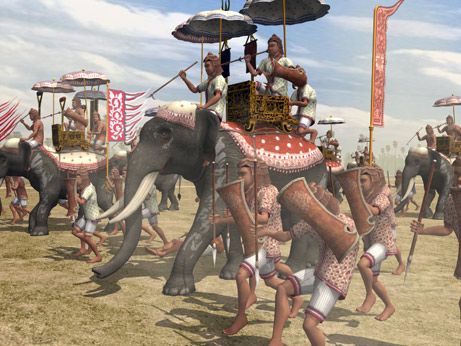
Khmerian war elephant in action. The crew consists of two men – or maybe the driver was deemed too insignificant to be depicted. It is hard to tell which of the two riders is of higher rank: the one with a javelin and shield on the elephant’s neck or the archer in the howdah. In Southeast Asia noble warriors traditionally fought sitting in front, and his rich armour and helmet also probably speak in favour of the first warrior. (Relief carvings, Angkor Thom, Cambodia, late 12th-early 13th centuries, after D. Nicolle)
Khmer elephants are depicted with a driver, armed with spear and shield, and a single archer or sometimes spearman. Those ridden by generals (identified by being shown enlarged) are accompanied by one or more parasol carriers on foot. Neither these nor elephants being shown in the background of infantry combats, Cham elephants are all crewed by a driver, a javelin-thrower, and a parasol bearer at the rear.
The artillery was Chinese-type “double crossbows” man-handled on wheels or mounted (or possibly only transported) on elephants Khmer troops in Cambodia placed double-bow crossbows on elephants. Several surviving images of the late 12th through to early 13th centuries show that it was not an experimental device. The idea of multiple crossbows was undoubtedly borrowed from China, where similar powerful installations comprising two to three bows were common at the siege and defence of fortresses. Nevertheless, only the Khmers put these crossbows on elephants’ backs.
Tuning the instruments of war
While today the thought alone may seem barbaric, the use of elephants during war was an effective tactic that wasn’t unique to Thailand. Yet before stepping onto a battlefield, elephants had to undergo training to ensure they were up to the task.
The more-aggressive male elephants were trained in loud environments amidst the sound of drums to simulate the environment of war to ensure they wouldn’t be spooked during conflict, and they were cajoled forwards into battle with the help of a spear. Sadly, such training hasn’t been left in the past; whilst the circumstances and finer details might be a little different, this concept of training such a majestic, wild animal still occurs today in Thailand. The practice of Phajaan, or crushing, is still used by mahouts who wish to make elephants rideable for tourists, a practice which is harmful for the animals and should never be done when visiting Thailand.
Historical use in Thailand
The use of elephants in war in the region began as early as the 9th-century. The Khmer Empire—now modern-day Cambodia—ruled Thailand for centuries, with war elephants an effective tool in their arsenal which helped them to conquer and subjugate those around them. The collapse of the Khmer Empire and the rise of Ayutthaya (modern-day Thailand) saw war elephants continue to be used in battle.
Ayutthaya faced many battles with the neighbouring Burma, who had a powerful military at the time, and both sides counted thousands of elephants in their ranks. Covered in armour, seating armed soldiers and capable of charging at speeds of up to 25km/h, elephants were the historical equivalent of a tank, and were feared on the battlefield. However, their most famous use in warfare in Thailand didn’t come during a general skirmish, but a bout of single combat.